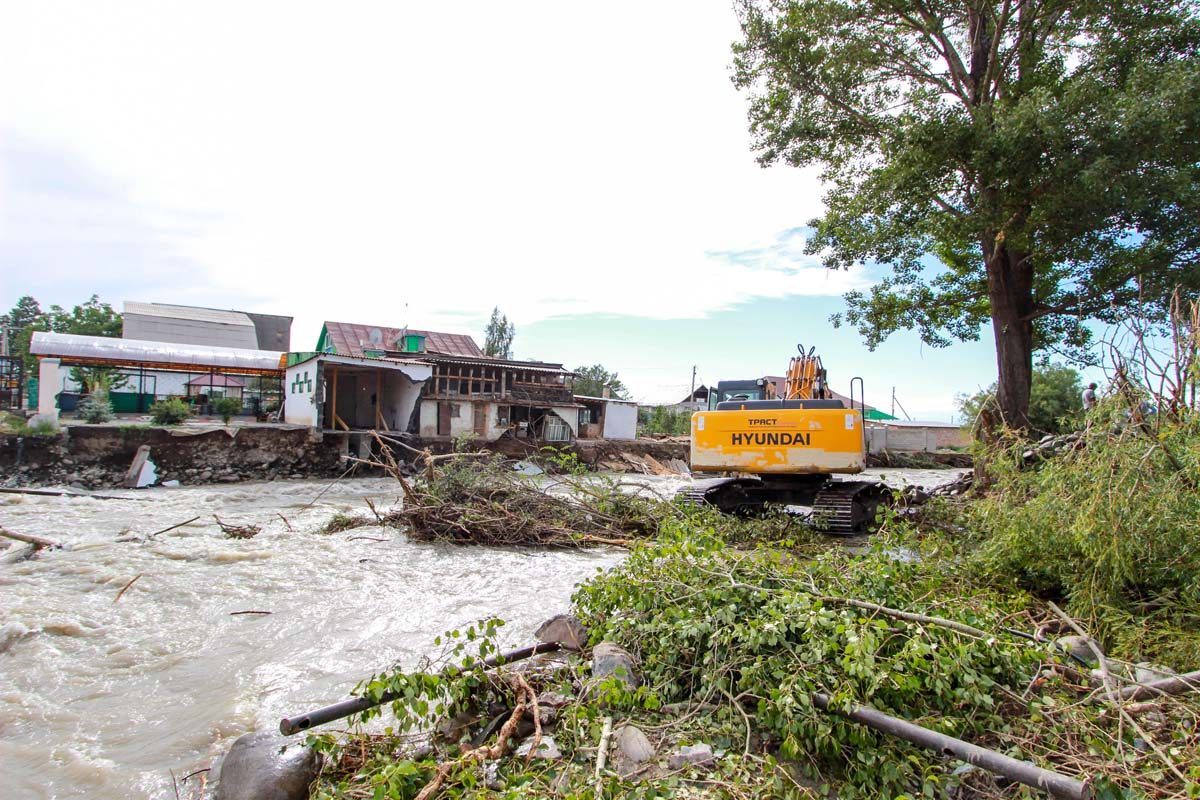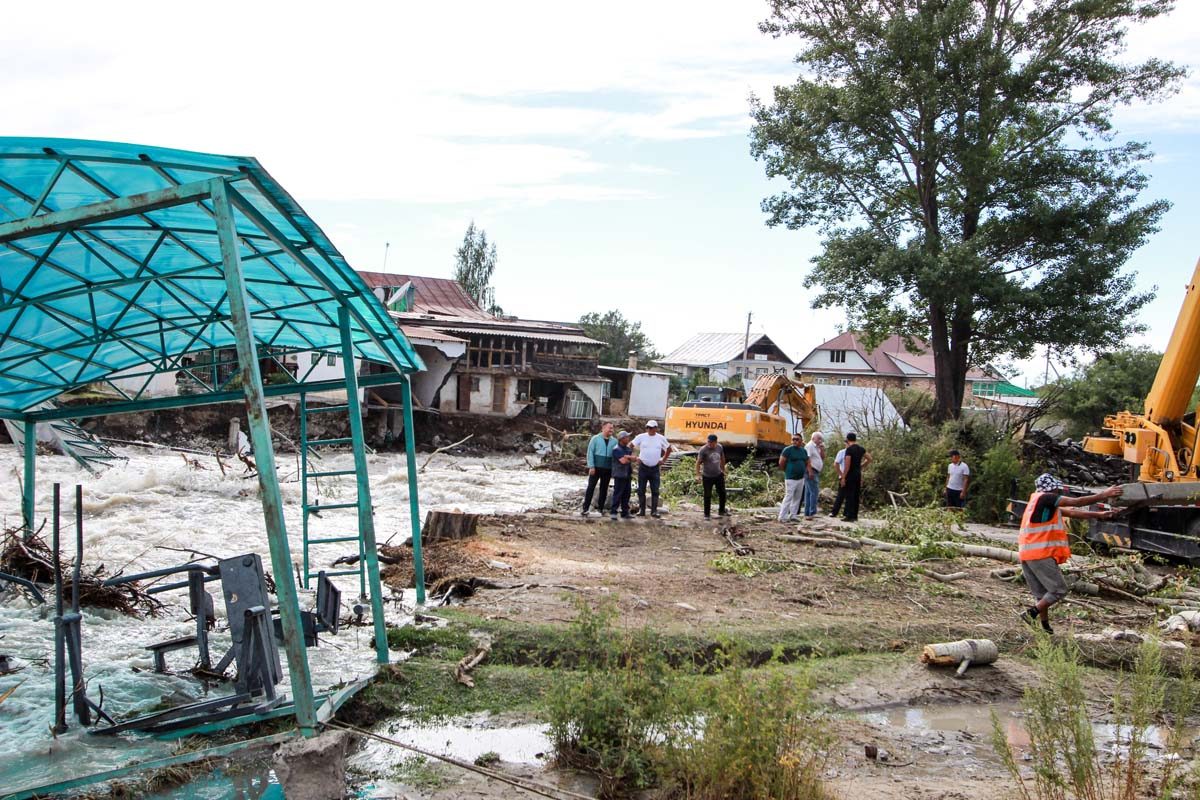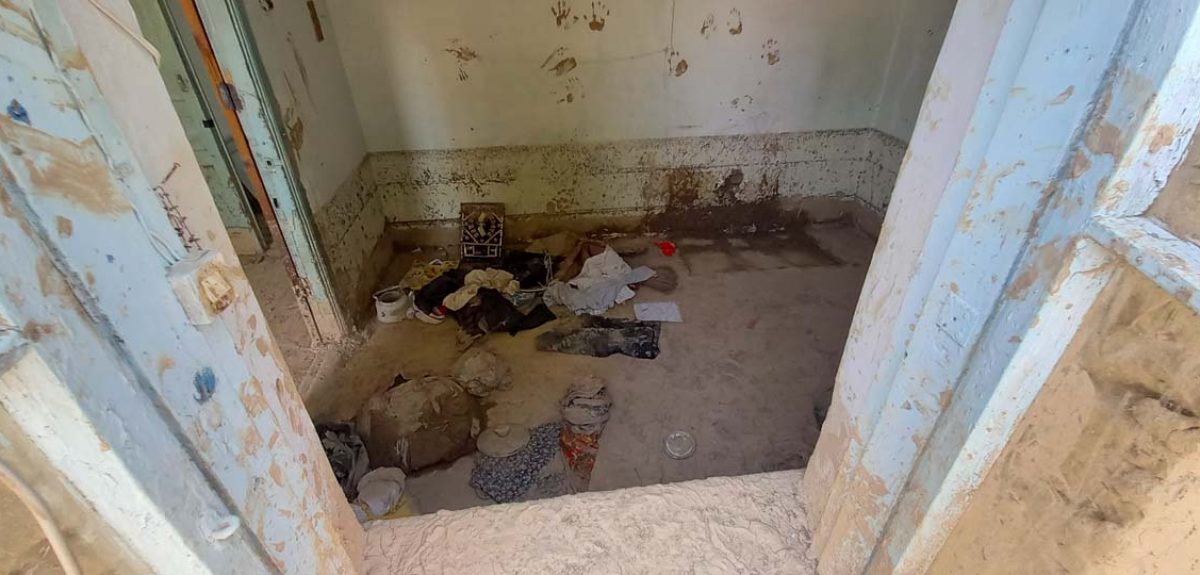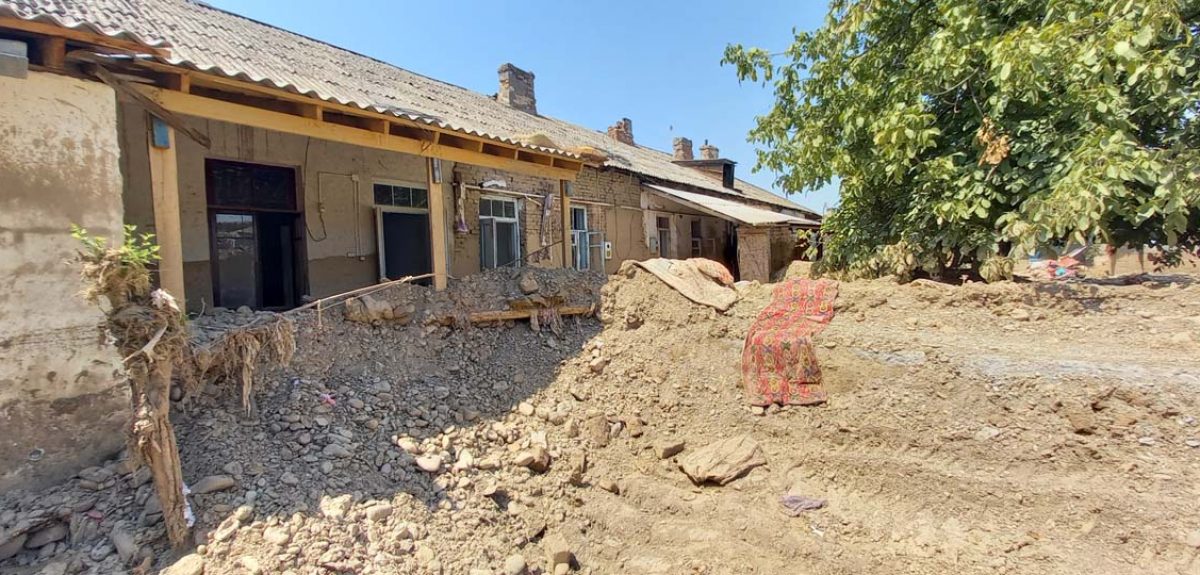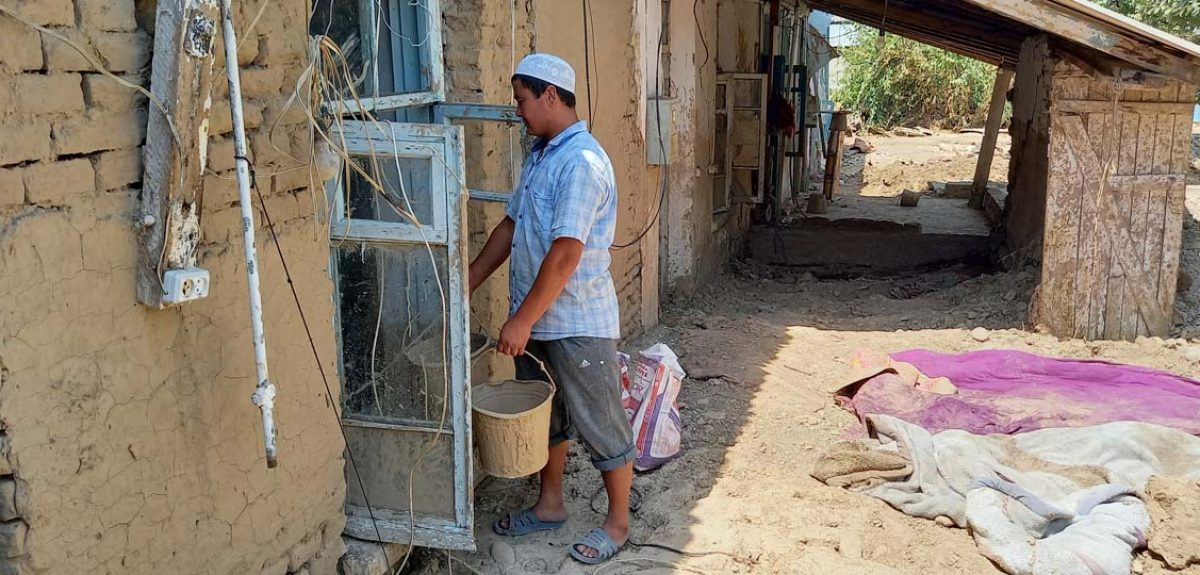According to experts, natural disasters in the world will become more frequent every year and their extent will be more catastrophic. Kyrgyzstan is not an exception with the area with a high risk of earthquakes and landslides. However, neither the government, nor the residents take this problem and its prevention seriously.

From July 30 to August 3, the largest mountain rivers in Issyk Kul region broke their banks because of heavy rainfall. The villages in Dzhety-Oguz and Ton districts suffered from it. In the town of Karakol, water flows flooded a few houses and farmlands, washed away roads, destroyed bridges and flooded the zoo.
“At 10 pm, I could literally feel the major water flow and I could hear the rocks rolling. Through the window, I saw how people began to shift around, neighbours came near, and literally within minutes two trees over the river were washed away. Afterwards, dogs started barking and I decided to let them out and their cage was broken down immediately,” a Karakol-based female resident of a destroyed house said.
Photo: CABAR.asia
In addition to the cage, the fence, a part of the garage and outbuildings were destroyed. According to her, emergency officers, the mayor came to her later in the day and promised to take measures. However, they started operations to clean the riverbed from fallen trees and to construct the temporary dam only on August 1.
Photo: CABAR.asia
“To be honest, the state provided aid only after we posted the video about what was happening here on the internet. Afterwards, they started to do something. We found the power shovel by ourselves, and the mayor’s office paid for diesel fuel and for two days of operations. They filled the dam between our house and the river. They said they would reinforce the sea wall,” she said.
According to her, five years ago her father applied to the authorities and asked them to strengthen the riverbank, yet failed.

Ten days before, the house of Bakhram Abdrazakov in Dzhalal-Abad region was flooded, and the yard was filled with crushed stone. He could hardly rescue his mother from the mudflow that occurred in the villages of Changyr-Tash and Dostuk, Dzhalal-Abad region, on July 20.
He bought the house recently and did not pay for it completely. Also, he did not have time to insure the house against natural disasters, but he hopes that the government will help to repair the house.
Photo: CABAR.asia
“The door does not open outward, the yard is full of rubble, whose level reaches the windows. My mother was at home. We with neighbours could hardly rescue her from the flood with the help of the rope,” Abdrazakov said.
The village of Changyr-Tash was recognised as dangerous for living a long time ago. According to Abdulnasir Zakirov, the head of the Administration of the Emergency Ministry of the Kyrgyz Republic for Dzhalal-Abad region, eleven mudflows occurred in the village of Changyr-Tash in 2012 and flooded houses, orchards and vegetable gardens. Afterwards, the officers of the administration wanted to relocate the residents to a safe place, but the latter refused to relocate. Therefore, they built a mudflow channel in order to protect the village from flooding.
Nine years later, the mudflow again flooded the village.

446 houses, a six-year-old girl died here and in the neighbouring village of Dostuk. 67 houses fell into disrepair, and the residents were moved to tents. Only 13 of all destroyed houses were insured, but the state department of insurance recognised only one house as unrepairable and is ready to pay for damage.
“Only 13 houses left under mudflows were insured. Water penetrated into 3 of 13 houses, and one of them is recognised as uninhabitable. Now we are doing our job,” said Erlan Kurmanaliev, a representative of the State Department of Insurance in Suzak district of Dzhalal-Abad region.

The campsite for the mudflow survivors was opened in the village of Kara-Daryya. Among them were little children and pregnant women. The house of Anzirat Abdrazakova was also flooded and it fell into disrepair. Now she lives with four children in a tent. Her husband left for Russia to earn money.

“We have food, yet we have no water for laundry. The mudflow washed away almost all children’s clothing. It is very hot in the afternoon, so I put my kids to sleep in the school gym. We need to build the house somehow, if the state allocates land plots to us soon,” she said.
The head of Kara-Daryya aiyl aimak, Nurbek Karaev, said that local authorities executes papers for land status transformation of a land plot with total area 30 hectares to make it suitable for the construction of residential houses and social facilities.
“Here, 68 houses were recognised as dangerous for living. Therefore, we did not clean the surrounding area of such houses. Once there’s a decision that they are uninhabitable, we’ll have to demolish them. So we are waiting not to do double job,” Karaev said.
(Non)compulsory insurance
According to Emergency Ministry, in Kyrgyzstan almost 4 thousand families live in dangerous areas prone to mudflows and landslides. Over half of them had received aid from the state before – namely, land plots and loans. However, despite the warning by Emergency Ministry, local authorities and court rulings, the residents do not abandon their houses and risk their lives every day.
“Relocated residents come back to their houses in dangerous zones, and the majority did not even leave the zone of risk. They are allured by pastures and land plots. Local authorities and other responsible agencies must get the situation under control. For example, we recommend to suspend the provision of public utilities,” according to the press service of the Emergency Ministry.
Once, the state used to issue loans to relocate residents from hazardous sites. But in 2016, the law was adopted on compulsory insurance of dwellings against fires and natural disasters. However, this practice is not widespread in the republic, and under 5 per cent of households have property insurance contracts.
Although insurance is compulsory by law, the State Insurance Organisation (GSO) has no levers of pressure on the people who do not insure their houses.
“We constantly raise awareness of the people, tell about the benefits of home insurance and payments. Unfortunately, almost 80 per cent of citizens do not have technical certificates for their residential premises. But we make advances to such people, we have simplified the mechanisms and now people can insure their premises having only a certificate issued by their aiyl okmotu proving that the property does belong to them,” said Nursultan Chekirov, the head of the department for organisational work and public relations of the State Insurance Company.
Neither money, nor desire
According to experts, the Kyrgyzstanis must take home insurance seriously. First, the country is prone to some natural disasters – earthquakes, floods, landslides, mudflows, high winds.
The entire territory of Kyrgyzstan is seismic and it has nearly 3 thousand earthquakes every year. The total area of lands prone to landslides is nearly 7.5 per cent of the area of the republic. The majority of landslides occur in Osh and Dzhalal-Abad regions. 600 localities are located in zones prone to landslides, and they will be at constant risk of landslides.

At an average, the republic has nearly 70 emergencies related to landslides and mudflows every year.
Second, the available risk financing facilities in the republic cannot handle the consequences of major catastrophic disasters.
“Therefore, the reduction of unfavourable financial impact of disasters caused by natural threats on the state, commercial facilities and households in the region should be considered as an important economic and social priority at the national and regional levels. Investing into development of the system of disaster risk transfer based on market laws both at the national and regional levels will bring numerous economic and financial benefits,” according to the report of the World Bank and the UN International Strategy for Disaster Reduction “Who will pay the bills of disasters?”
According to the Emergency Ministry, the annual average economic loss from emergencies in Kyrgyzstan (including conflict situations and major road traffic accidents) reaches over 700 million som (8.26 million dollars). The major part of such losses falls on natural calamities.
To prevent natural disasters the government takes measures in two directions: capital construction and prevention, liquidation of emergencies. 400 million soms (4.7 million dollars) are allocated every year from the budget for this purpose.
“This year, two reinforced concrete dam members and dams 4.664 metres long were built. As a result, 3.5 thousand families and 5.016 hectares of farming land are protected. Moreover, works are in progress at 200 objects to prevent emergency. The above measures: construction of protective works, mechanical cleaning of mudflow channels, prove to be highly effective,” according to the Emergency Ministry.
However, independent experts think that the work of the government to prevent natural calamities is inefficient. Anara Sultangazieva, the head of “Green Energy” Public Foundation and the member of the board of the “Green Alliance of Kyrgyzstan”, said that the programmes and plans in this direction are inefficient.
“One of the key problems is economic, political instability. Our leaders, cabinet of ministers change very often. Our human resources policy is weak, salaries are low, therefore, we have a high turnover of staff. They have plans, actions, programmes that have been implemented for 20 per cent only. I have monitored their activities. Everything remains on paper,” the expert said to CABAR.asia.
In addition to the destroyed management system, according to Sultangazieva, the emergency situation is being aggravated by irresponsibility of citizens.
“They do not listen to advices, recommendations given by governing bodies. They ignore their warnings and remain in the areas hazardous for living because they think that nothing would probably happen. They destroy the ecosystem, cut trees down. This leads to the bigger catastrophe,” the ecologist said.
According to forecasts of local and intenrational experts, natural disasters will become more frequent every year and their extent will be more catastrophic. Global warming becomes obvious.
“We fight fires and their consequences. We need to strengthen interaction between local authorities and other state bodies. We should involve the media, ecologists, experts, NGOs. We always give recommendations regarding each matter. However, they have a thousand of excuses to our proposed solutions. They either have no money, or desire. They just divide the grants between themselves. They do not care about ecology and safety of people,” Sultangazieva said.
This article was prepared as part of the Amplify, Verify, Engage: Information for Democratisation and Good Governance in Eurasia project implemented by IWPR and funded by the Norwegian Ministry of Foreign Affairs, and mentoring program of the Development of New Media and Digital Journalism in Central Asia project implemented by IWPR with the financial support of the UK Government. The content of the article does not reflect the official position of the IWPR, the Norwegian Ministry of Foreign Affairs, or the Government of the United Kingdom.





